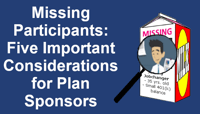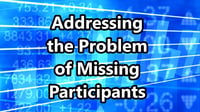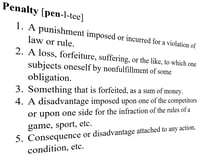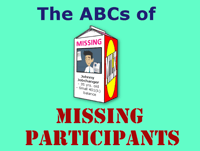Consolidation Corner
-
Blog
- 401k Cash Outs
- 401k Consolidation
- 401k Plan Termination
- America's Mobile Workforce
- Assisted Roll-in
- Auto Enrollment
- Auto Portability
- Auto Portability Simulation
- Automatic Roll-In
- Automatic Rollover
- Automatic Rollovers
- Boston Research Technologies
- CARES act
- Common Mistakes
- DIY Roll-In
- DOL Advisory Opinion
- EBRI
- Employee Benefit News
- ERISA Advisory Council
- Financial Services Roundtable
- Financial Wellness
- How-To
- In-Plan Consolidation
- Leakage
- Lifetime Plan Participation
- Lost Participants
- Managed Portability
- Mandatory Distributions
- MarketWatch
- Missing Participant IRA
- Missing Participants
- National Retirement Savings Cash Out Clock
- Participant Transition Management
- PLANSPONSOR
- Portability Services Network
- PSCA
- Public Policy
- RCH Services
- Retirement Income
- Retirement Plan Portability
- retirement research
- Retirement Savings Consolidation
- Retirement Savings Portability
- Roll-In
- Safe Harbor IRA
- Saver's Match
- Security
- Small Accounts
- Stale Dated Checks
- Synthetic Tenure
- Uncashed Check Services
- Uncashed Distribution Checks
- Video
- Webcast
- What is a Missing Participant?
Lost Participants
Consolidation Corner Blog
Consolidation Corner is the Retirement Clearinghouse (RCH) blog, and features the latest articles and bylines from our executives, addressing important retirement savings portability topics.
Senate Hearing Reveals Large Employer Support for Auto Portability
 During testimony in a July 28th hearing held by the Senate Finance Committee (Building on Bipartisan Retirement Legislation: How Can Congress Help?), Aliya Robinson, Senior Vice President of Retirement and Compensation Policy for the ERISA Advisory Committee (ERIC), twice voiced her support for auto portability, the new plan feature that automatically moves small balances to the new employer’s plan when participants change jobs.
During testimony in a July 28th hearing held by the Senate Finance Committee (Building on Bipartisan Retirement Legislation: How Can Congress Help?), Aliya Robinson, Senior Vice President of Retirement and Compensation Policy for the ERISA Advisory Committee (ERIC), twice voiced her support for auto portability, the new plan feature that automatically moves small balances to the new employer’s plan when participants change jobs.
This One Simple Trick Radically Boosts Financial Wellness!
 401(k) Plan Sponsors: How would you like to radically boost your participants’ financial wellness, increase your plan’s assets, reduce your plan’s costs, and prevent missing participants?
401(k) Plan Sponsors: How would you like to radically boost your participants’ financial wellness, increase your plan’s assets, reduce your plan’s costs, and prevent missing participants?
Adopting this one simple and proven trick – retirement savings portability – delivers all this and more!
Missing Participants: Five Important Considerations for Plan Sponsors
 The problem of missing participants in employer-sponsored retirement plans is one of the most important, yet perplexing issues facing plan sponsors, and for good reason.
The problem of missing participants in employer-sponsored retirement plans is one of the most important, yet perplexing issues facing plan sponsors, and for good reason.
Ensuring that participants (or their beneficiaries) receive their benefits is the essence of an employer’s fiduciary responsibility – and missing or unresponsive participants who become separated from those benefits can generate significant risks for plan fiduciaries.
The Playbook for Conducting Diligent Missing Participant Searches
 Sponsors of active retirement plans are increasingly challenged by the problem of missing participants, and the difficulties they face in performing diligent searches. After all, ensuring that plan participants (or their beneficiaries) receive the benefits they’re owed is a sponsor’s primary fiduciary responsibility.
Sponsors of active retirement plans are increasingly challenged by the problem of missing participants, and the difficulties they face in performing diligent searches. After all, ensuring that plan participants (or their beneficiaries) receive the benefits they’re owed is a sponsor’s primary fiduciary responsibility.
RCH Releases New Video “Addressing the Problem of Missing Participants”

Retirement Clearinghouse (RCH) has released a new video “Addressing the Problem of Missing Participants.” The video integrates new research findings from the March 2018 study “The Mobile Workforce’s Missing Participant Problem” and provides viewers with the most-complete and factual summary of the problem, including:
The Fundamentals of Locating Missing Participants
This video presentation is designed to give the viewer a basic understanding of the principles of locating missing participants in 401(k) plans.
New Penalties for Lost Participants Take Effect

In November of 2015, Congress enacted the Federal Civil Monetary Penalties Inflation Adjustment Act Improvements Act to apply inflation adjustments to various penalties defined under the Federal Civil Inflation Adjustment Act of 1990. One of those penalties was the $10 per employee penalty for failure to furnish reports to certain former participants and beneficiaries or maintain records. The new penalty, as published in the Federal Register (Table C), is now $28 per employee, effective August 1, 2016.
Reducing the Burden of Missing Participants
Whenever I am meeting with a plan sponsor, TPA or recordkeeper for the first time, I ask about returned mail related to missing participants; and almost every time I get…“the look”. The look and/or eye roll that instantly says that returned mail is definitely a problem. The entire retirement industry is all-too-familiar with returned mail related to missing participants. In addition to the money wasted on materials and mailing costs, missing participants create administrative burdens and increase the plan’s fiduciary liability risk. So, what’s a fiduciary to do?
Automatically Moving Mandatory Distributions Forward
The Case for Automatically Moving Mandatory Distributions Forward
The mandatory distribution-to-Safe Harbor IRA plan feature as commonly utilized today was conceived in 2001 and launched in 2005 with good intentions, and for valid reasons. A mobile workforce, combined with a lack of retirement savings portability, had created a burgeoning problem for plan sponsors: an explosion of small-balance (less than $5,000) accounts left “stranded” in-plan, resulting in rampant cashouts, missing participants, uncashed distribution checks and the like. These problems only accelerated with the widespread adoption of auto enrollment, beginning in 2009.
-
Blog
- 401k Cash Outs
- 401k Consolidation
- 401k Plan Termination
- America's Mobile Workforce
- Assisted Roll-in
- Auto Enrollment
- Auto Portability
- Auto Portability Simulation
- Automatic Roll-In
- Automatic Rollover
- Automatic Rollovers
- Boston Research Technologies
- CARES act
- Common Mistakes
- DIY Roll-In
- DOL Advisory Opinion
- EBRI
- Employee Benefit News
- ERISA Advisory Council
- Financial Services Roundtable
- Financial Wellness
- How-To
- In-Plan Consolidation
- Leakage
- Lifetime Plan Participation
- Lost Participants
- Managed Portability
- Mandatory Distributions
- MarketWatch
- Missing Participant IRA
- Missing Participants
- National Retirement Savings Cash Out Clock
- Participant Transition Management
- PLANSPONSOR
- Portability Services Network
- PSCA
- Public Policy
- RCH Services
- Retirement Income
- Retirement Plan Portability
- retirement research
- Retirement Savings Consolidation
- Retirement Savings Portability
- Roll-In
- Safe Harbor IRA
- Saver's Match
- Security
- Small Accounts
- Stale Dated Checks
- Synthetic Tenure
- Uncashed Check Services
- Uncashed Distribution Checks
- Video
- Webcast
- What is a Missing Participant?

 What is a Missing Participant?
What is a Missing Participant?